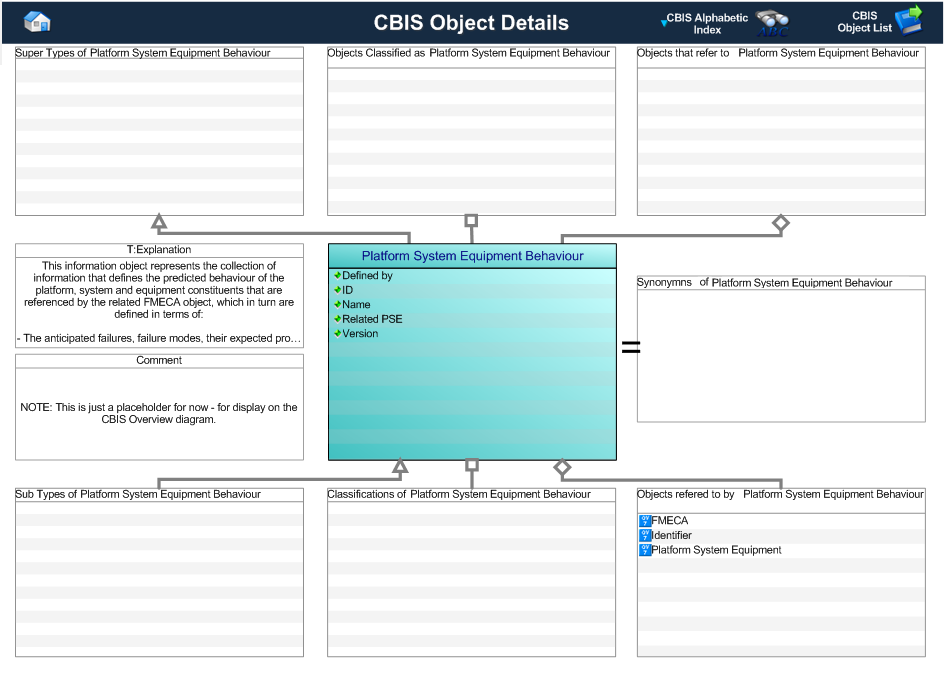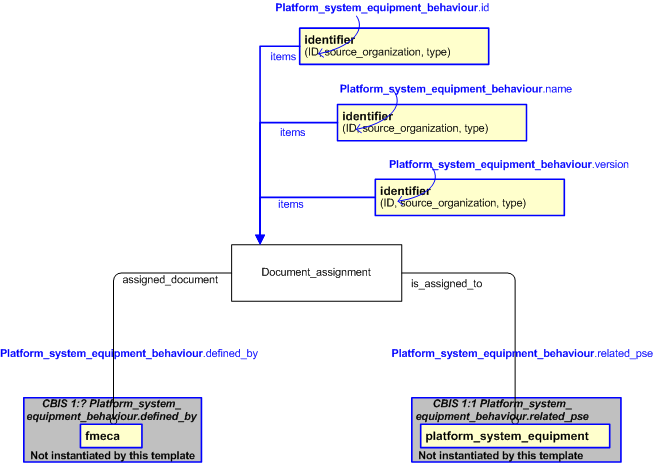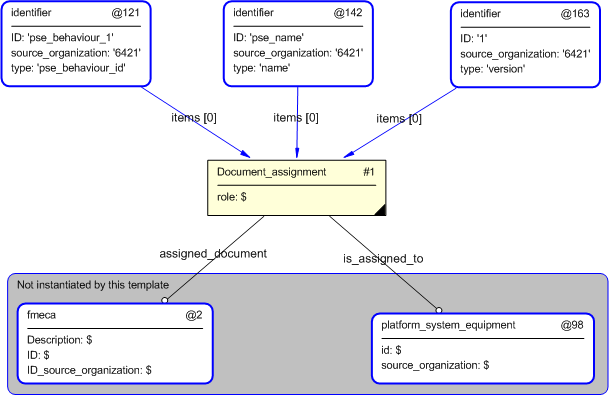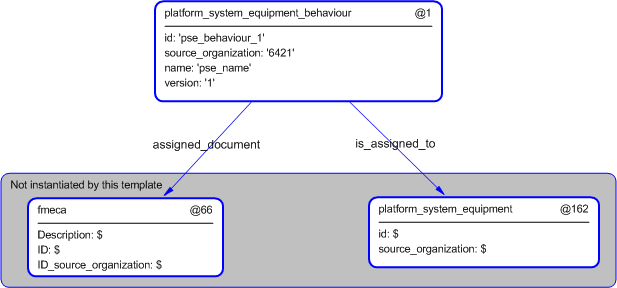Template:— platform_system_equipment_behaviour (pse_bhvr)
Context:— UK_Defence |
Date: 2009/04/17 10:48:48
Revision: 1.6
|
This section specifies the template platform_system_equipment_behaviour.
NOTE
The template has been defined in the context of
UK_Defence.
Refer to the business context for details of related templates.
NOTE
An explanation of a template and the associated instantiation path is
provided in the
Template overview
section.
This template describes how to represent the collection of information that defines the predicted behaviour of the platform,
system and equipment constituents that are referenced by the related FMECA object, which in turn are defined in terms of:
- The anticipated failures, failure modes, their expected probabilities, frequencies of occurrence and effects.
- The consequences of expected failures and failure modes
Figure 1 — Graphical Representation for Business Object platform_system_equipment_behaviour
platform_system_equipment_behaviour
The definition of a anomaly object is:
This information object represents information about an actual platform_system_equipment_behaviour of an individual
product.
|
Attribute name
|
Attribute description
|
Attribute type
|
Optionality
|
| Defined by |
This is the reference to the set of FMECA that defines the PSE behaviour. |
Relationship to FMECA. |
Mandatory (1:?) |
| ID |
This is the identifier of the PSE behaviour. |
Identifier |
Mandatory |
| Identifier.id |
This is the value of the id attribute of the Identifier applied to the PSE behaviour. |
intrinsic |
Mandatory |
| Identifier.type |
This attribute is the type associated with the id of the Identifier given to the PSE behaviour. |
PSE_behaviour_id |
Mandatory |
| Identifier.source_organization |
This attribute is the value representing the source organization that provides the id of the Identifier given to the PSE behaviour.
This value is assumed to be a type of Organization_identification_code.
|
Organization_identification_code |
Mandatory |
| Name |
This is the name of the PSE behaviour. |
intrinsic |
Mandatory |
| Related PSE |
This is the reference to the platform, system and equipment for which the related FMECA's have been conducted. |
Relationship to Platform System Equipment. |
Mandatory |
| Version |
This is the version of the PSE behaviour. |
intrinsic |
Mandatory |
Table 1 — platform_system_equipment_behaviour attribute details
The EXPRESS-G diagram in
Figure
2
shows the templates and EXPRESS entities that are required
to represent the template
"platform_system_equipment_behaviour".
The text highlighted in blue shows the template parameters.
Figure 2 — An EXPRESS-G representation of the Information model for platform_system_equipment_behaviour
The graphic for the template to be used in other EXPRESS-G diagrams
is shown in Figure
3
below.
Figure 3 — The graphical representation of the platform_system_equipment_behaviour template
The following input parameters are defined for this template:
This is the reference to the platform, system and equipment for which the related FMECA's have been conducted.
This is the reference to the set of FMECA that defines the PSE behaviour.
This is the identifier of the PSE behaviour.
An Organization representing the identification/rectification authority for the behaviour.
This is the name of the PSE behaviour.
The version (identifier) of the PSE behaviour.
The following reference parameters are defined for this template:
Allow the
Document_assignment
entity instantiated in this path to be referenced when this template is used.
%^target = $platform_system_equipment_behaviour.pse_behaviour%
The collection of information that defines the predicted behaviour of the platform, system and equipment constituents that
are referenced by the related FMECA object.
The instantiation path shown below specifies the entities that are to be
instantiated by the template.
A description of templates and the syntax for the instantiation path is
provided in the
Templates Help/Information section.
-- Create failure_type_consequence %^pse_behaviour =
Document_assignment%
-- id identifier /
identifier(
ID=@id,
source_organization=@source_organization,
type='pse_behaviour_id',
items=^pse_behaviour)/
-- name identifier /
identifier(
ID=@name,
source_organization=@source_organization,
type='name',
items=^pse_behaviour)/
-- version identifier /
identifier(
ID=@version,
source_organization=@source_organization,
type='version',
items=^pse_behaviour)/
-- The consequential relationship between the failure type during usage and the consequence.
^pse_behaviour.is_assigned_to ->
@related_pse
^pse_behaviour.assigned_document ->
@defined_by
The instance diagram in Figure
4
shows an example of the EXPRESS entities and templates that are instantiated by the template:
/platform_system_equipment_behaviour(defined_by='#2', id='pse_behaviour_1', source_organization='6421', name='pse_name', related_pse='#98', version='1')/
(an illustration of the consolidated platform_system_equipment_behaviour template is shown in
Figure
5 below.)
Figure 4 — Entities instantiated by platform_system_equipment_behaviour template
The instance diagram in
Figure
5
shows the graphic symbol for the template that is to be
used in other instance diagrams. The example template is:
/platform_system_equipment_behaviour(defined_by='#2', id='pse_behaviour_1', source_organization='6421', name='pse_name', related_pse='#98', version='1')/
Figure 5 — Instantiation of platform_system_equipment_behaviour template
Characterizations
No common characterizations of the template
platform_system_equipment_behaviour
have been identified. However, the ISO 10303-239 EXPRESS model
may enable other assignments to the entities instantiated by the template.




